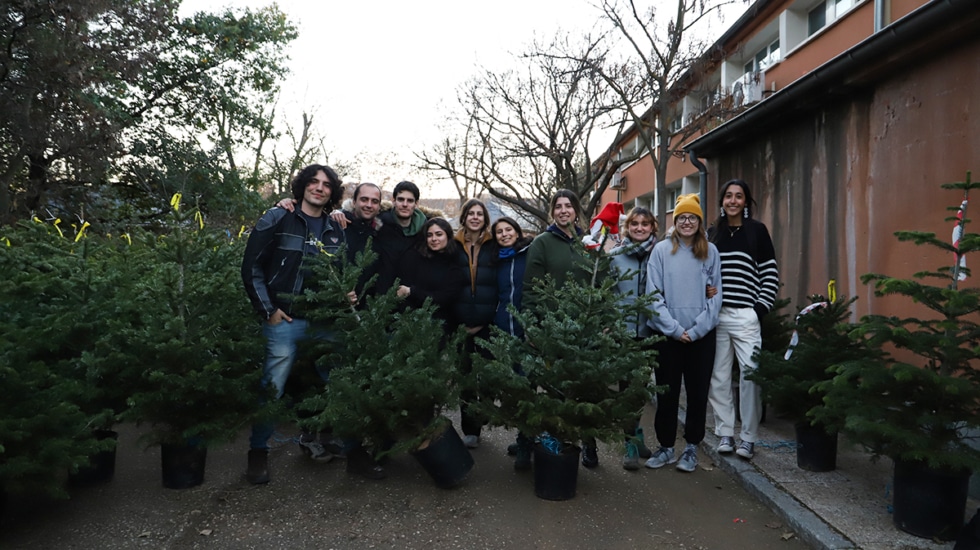

Students from the Higher Technical Schools of Forestry Engineers, Agronomists and the University School of Forestry of Madrid sell natural spruce trees.
In Spain, the natural Christmas tree is not the most common sight. Most opt for synthetic, which is stored in a box for a year and taken out again when these dates arrive. This is probably more convenient, but it is also much more polluting. And although it may seem contradictory, Natural Christmas trees have many environmental benefits even if they are cut out for display in homes.
First of all, this is a natural product, which, unlike synthetic It has no carbon footprint, produces no waste and does not require petroleum to produce. Like all vegetation, they also capture CO2. Moreover, its cultivation creates jobs in areas that often suffer from depopulation problems. Therefore, some experts doubt that these trees would even exist if not for commercial demand, which increases sharply during the Christmas period.
There are extensive crops of natural Christmas trees grown in areas of the United States and Northern Europe. Many of them are planted, many are cut down, and they are the ones that end up in houses. As for the rest, as he explains The newspaper “New York Times In a recent article They form true forest farms that effectively function as a “small forest”.attracting large amounts of fauna and allowing the use of agricultural land that would otherwise be abandoned.
“People don’t know all the benefits they have. This is not about each person going up the mountain with an ax and cutting down everything he wants, as happened in the beginning, but about the fact that the relevant managers are responsible for this. Because it is like livestock: the worst specimens are sacrificed first, and the best are left to reproduce,” explains Eduardo Rojas Briales, dean of the Official College of Forestry Engineers.
Rojas clarifies that this type of tree was never a Spanish tradition. But In the late 60s and early 70s they began to become popular in our country thanks to European and American films.. Later, according to the expert, their sales here stagnated as some environmentalists criticized them in a childish way, arguing that their impact on the environment was negative.
Since then, the tradition has been preserved only in those areas where these trees are grown (Basque Country, Navarre, Catalonia and, to a lesser extent, Aragon) and in Madrid. In these regions, according to Rojas, the market It’s large and accessible, and the prices are “reasonable.”. But in the rest of Spain, where they have not yet fully taken root, prices are skyrocketing. “If you do the math, the price of plastic wood is cheaper. But it’s not the same,” the expert concludes.
At a general level there is two types of trees that are used as decorative elements for Christmas: pure Pyrenean fir and red fir. The second grows faster and is more common in Europe, but is less common in Spain, since the temperature of our country is far from an ideal climate.
Familiar product
There are several ways to purchase a natural Christmas tree in Madrid. One of them is to enroll in the School of Forestry, where students study at the Higher Technical Schools of Forestry Engineers, Agronomists and the University School of Forestry Engineering of the Polytechnic University of Madrid (UPM). They are on sale until December 23rd.
“This is a tradition that is over 60 years old.“Explains Alejandro Duro, one of the students. “We organized ourselves into groups without the help of teachers, so that we could sell them in shifts and be able to combine it with classes. And with the money we receive, we will organize a trip at the end of the year, which we want to make to Thailand this year,” he adds.
They sell spruces there, whose leaves are softer and greener, and red spruces, which are leafier, have shorter leaves and smell very pleasant. Prices range from 35 euros for the smallest trees and 100 to 200 euros for the largest trees.which can reach four meters in height.
“People take everything. Many people even take two,” says Duro. Most of his clients are families, he said, but they also see many older people and a fair number of former schoolchildren. “The main thing is to protect the tree from heat sources. They can be good both on the terrace and inside the house. From there, you just need to keep the soil moist, like any other plant,” he concludes. Thus, he assures, they can last even for years.
The specimens sold there come from Lleida, from a culture that the school itself considers “environmentally friendly.” As stated on their website, they all have roots: either they are rooted spruce trees, having primary and secondary roots, or they are tapered, that is, they grew outside the pot and have only primary roots.
Anyway, Many people prefer to buy them and then plant them in the bushes., taking advantage of the fact that they are biodegradable products that, when they die, can also be used to produce organic fertilizers. From the school itself, they remember that those who want to take the tree home but do not know how to transport it can choose a home delivery service, and that a portion of the profits made is reserved for donation to Caritas.
Source: El Independiente